from A newsletter for proactive planning... In this edition... Selling online – When do you need to tell HMRC? Check your National Insurance record Dispose of assets before 6 April 2024 to take advantage of the higher annual exempt amount Making use of your inheritance tax allowances Understanding your tax code Tax Diary - February 2024 March 2024 Issue www.compassaccountants.co.uk

PAGE 2 Selling online – When do you need to tell HMRC? Earlier in the year, it was erroneously reported in the press that new tax rules were coming into force which would mean that anyone selling online would need to tell HMRC and pay tax on their earnings. There is, however, no change in the tax rules, which apply to online sellers as they do to other traders. However, from 1 January 2024 onwards, digital platforms are now required to collect information on online sellers and their income, and they must report this to HMRC by January 2025. Consequently, online sellers who have previously failed to declare taxable income may now come to HMRC’s attention. Taxable income and gains Not everyone selling online will need to pay tax or tell HMRC. This is only necessary if the person is trading or makes a capital gain. A person selling some old clothes on Vinted for less than they paid for them does not need to tell HMRC about their income or pay tax on it. Trading A person will normally be trading if they sell goods or services for a profit. The normal ‘badges of trade’ apply to determine whether a trade exists. An online seller who is trading must tell HMRC about their income if their gross trading income is more than £1,000 in the tax year. This limit applies to all income from trading – not just that from online sales. The £1,000 trading allowance means that if gross trading income is less than £1,000, the income can be enjoyed tax-free and does not need to be reported to HMRC. If gross trading income is more than £1,000, the trader has the option of deducting the trading allowance or their actual expenses. Where actual expenses are less than £1,000, it will be beneficial to deduct the £1,000 trading allowance instead to arrive at the taxable profit. If the trader has made a loss from selling online, they may wish to report this, even if their gross trading income is below the £1,000 limit. This will allow them to utilise the loss. Where income from online selling needs to be reported to HMRC, this is done in the SelfEmployment pages of the Self Assessment tax return. New online sellers who have not previously filed a return will need to register for Self Assessment no later than 5 October after the end of the tax year in which their trade commenced (so by 5 October 2024 where they started their trade in the 2023/24 tax year). Capital gains An online seller may also need to tell HMRC if they make a chargeable gain. However, the chattels rules mean that a gain on a single chattel only needs to be declared if the proceeds are more than £6,000 and the chattel is not exempt, as is the case for private cars.

PAGE 3 Check your National Insurance record Paying National Insurance contributions allows individuals to earn qualifying years, which in turn provides them with entitlement to the state pension and certain contributory benefits. Entitlement may also be provided by the award of National Insurance credits. State pension entitlement A person reaching state pension age on or after 6 April 2016 needs 35 qualifying years to benefit from the full state pension. A person who has less than 35 qualifying years but at least ten on reaching state pension age will receive a reduced state pension. It is important to check your National Insurance record to see if you will qualify for the full state pension. This can be done online by visiting www.gov.uk/check-statepension. Gaps can be filled in by paying voluntary contributions. Class 3 voluntary contributions Class 3 National Insurance contributions are voluntary contributions which can be paid to buy additional qualifying years to boost your state pension. Each additional qualifying year increases the state pension by 1/35th. At 2023/24 rates, each additional qualifying year up to the 35 qualifying year maximum increases the state pension by £5.82 a week (£302.86 a year). For 2023/24, Class 3 contributions are payable at a rate of £17.45 a week. The rate is to remain at this level for 2024/25. Class 3 voluntary contributions must be paid within six years of the end of the tax year to which they relate, so by 5 April 2030 for 2023/24 contributions. However, unless the contribution relates to the either of the previous two tax years, it is payable at the rate in force when the contribution is made, rather than that applying for the missing year. Individuals reaching state pension age on or after 6 April 2016 who have missing years between 6 April 2006 and 5 April 2016 (2006/07 to 2015/16) can benefit from an extended window in which to pay contributions for those years. Contributions must be paid by 5 April 2025 and can be paid at the 2022/23 rate of £15.85 per week. Making voluntary contributions is only worthwhile if, after making the contributions, you have at least ten qualifying years. If you have missing years, but will secure 35 qualifying years by the time you reach state pension age, there is no point in making voluntary contributions. Paying Class 2 contributions voluntarily A self-employed earner whose earnings are below the small profits threshold does not benefit from the National Insurance credit available to those whose profits are between the small profits threshold and the lower profits threshold. However, they do have the option to pay Class 2 contributions voluntarily. Where this option is available, at £3.45 per week for 2023/24, this is a much cheaper option than paying Class 3 contributions. Following the abolition of Class 2 contributions from 6 April 2024, self-employed earners will still be able to make voluntary contributions at the 2023/24 Class 2 rate of £3.45 per week. Like Class 3, voluntary Class 2 contributions must be paid within six years from the end of the tax year to which they relate. The contribution is paid at the highest rate in force in the period from the year to which it relates to the year in which it was paid. An extended deadline of 5 April 2025 applies by which to make contributions for missing years between 2006/07 and 2015/16 inclusive. These can be paid at the 2022/23 rate of £3.15 per week.
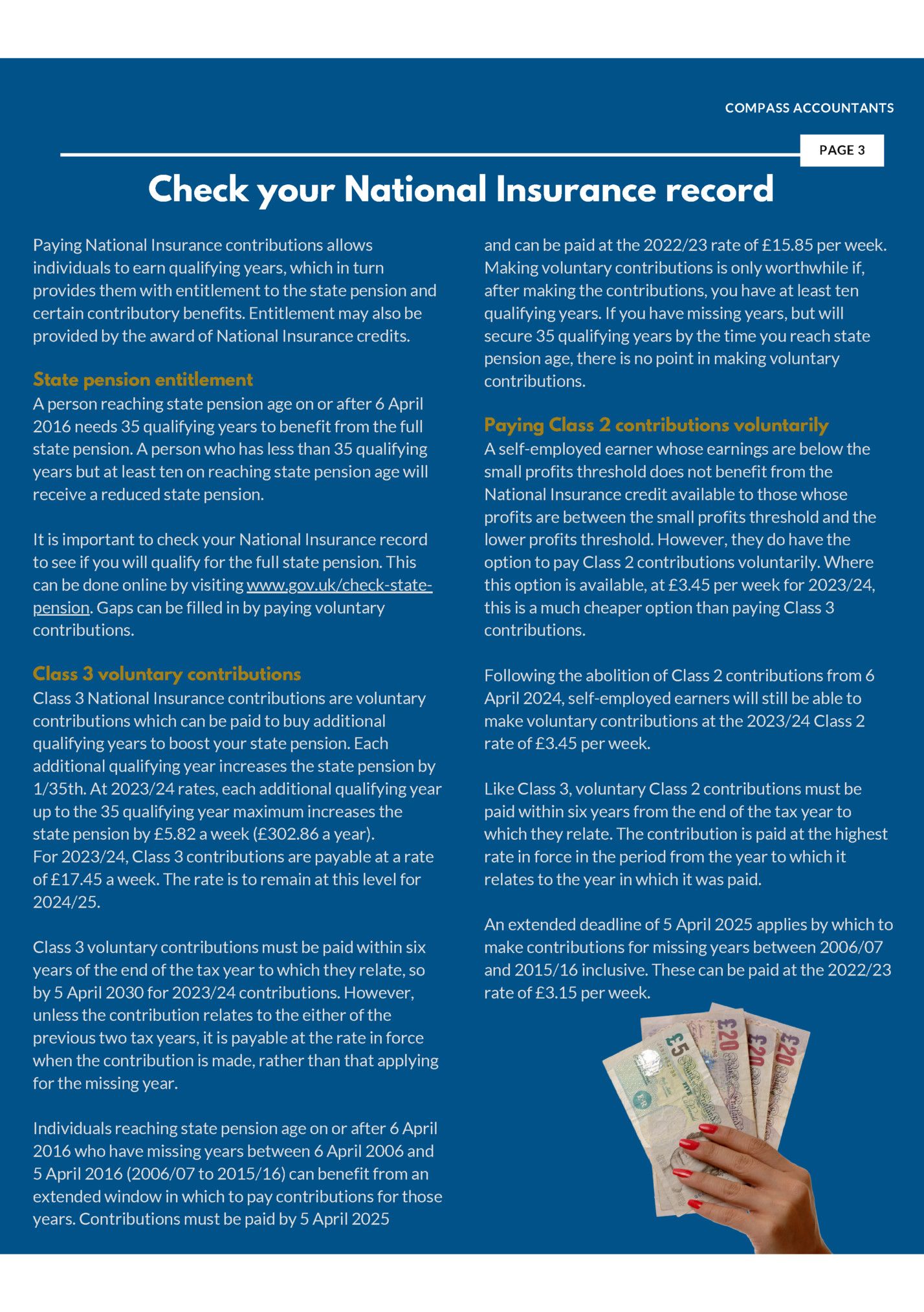
PAGE 4 Dispose of assets before 6 April 2024 to take advantage of the higher annual exempt amount Individuals making capital disposals do not pay capital gains tax if their net gains for the tax year (chargeable gains less allowable losses for the year) are covered by the annual exempt amount. This is essentially a personal allowance for capital gains tax purposes, and each individual is entitled to their own annual exempt amount. The annual exempt amount is set at £6,000 for 2023/24 (down from £12,300 for 2022/23). It is further reduced to £3,000 for 2024/25. If it is not used in the tax year, it is lost – it cannot be carried forward. If you are planning disposals that are likely to trigger a gain, it is important to consider the timing and, where the 2023/24 annual exempt amount remains available, whether to make the disposal before the 2023/24 tax year comes to an end on 5 April 2024. Case study 1 Jacob has not made any disposals in 2023/24. He is planning on selling a residential investment property which will realise a gain of £20,000. Jacob is single and pays tax at the higher rate. By making the disposal before the end of the 2023/24 tax year, Jacob will be able to use his 2023/24 annual exempt amount of £6,000, leaving him with a gain of £14,000 on which capital gains tax of £3,920 (£14,000 @ 28%) is payable. However, if he delays the disposal until after 5 April 2024, he will only benefit from an annual exempt amount of £3,000, leaving a chargeable gain of £17,000 on which capital gains tax of £4,760 will be due. By making the disposal before 6 April 2024, Jacob is able to save tax of £840. He is also able to preserve his 2024/25 annual exempt amount. Case study 2 Jane sold a flat in May 2023 realising a loss of £15,000. She plans to sell a painting which will realise a gain of £2,000. CONT ON PG 3
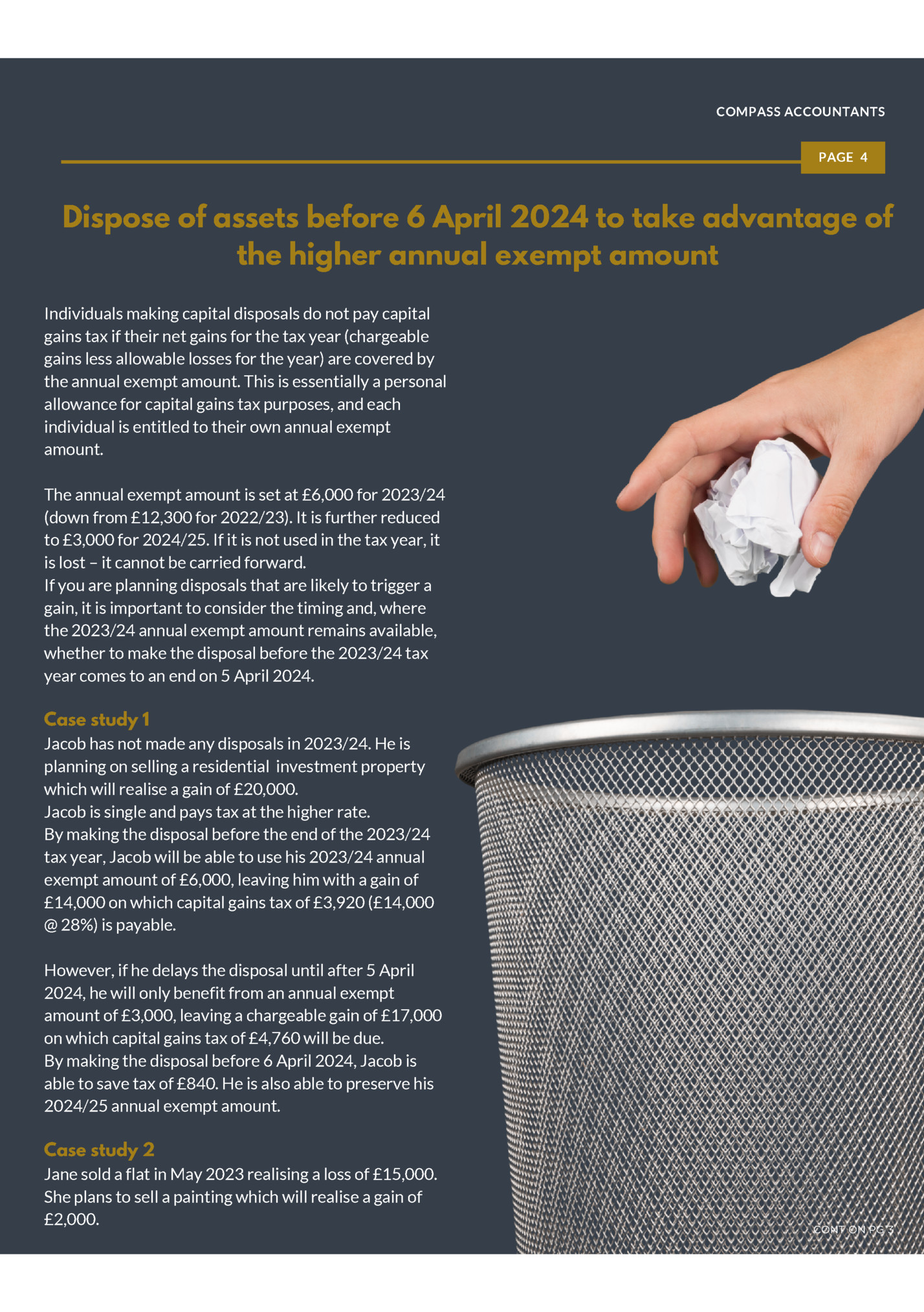
PAGE 5 If Jane sells the painting in 2023/24, the gain of £2,000 will be set against the loss of £15,000, reducing the net loss available to carry forward to £13,000. Her annual exempt amount for 2023/24 will be wasted. If Jane makes the disposal in 2024/25, and this is her only disposal in that year, it will be sheltered by the annual exempt amount of £3,000. Jane will have losses from 2023/24 of £15,000 to carry forward to set against future gains. Case study 3 John has made chargeable gains of £8,000 in 2023/24. He plans to sell a holiday home, realising a gain of £30,000. If he sells the property before 6 April 2024, the full gain will be taxable as he has already used his annual exempt amount. However, if he waits until after 5 April 2024 to make the disposal, he will be able to use his 2024/25annual exempt amount to reduce the chargeable gain to £27,000, reducing his tax bill by £840 if he is a higher rate taxpayer. Spouses and civil partners Spouses and civil partners each have their own annual exempt amount. While they cannot pass unused annual exempt amounts to their partner, they can transfer assets between themselves at a value that gives rise to neither a gain nor a loss. When planning asset disposals, spouses and civil partners need consider not only their own available annual exempt amount, but also that of their spouse/civil partner, and the rate at which they each pay tax. If you have used your annual exempt amount for 2023/24 but your spouse has not, it may be worth transferring the asset to them prior to disposal and making the disposal before 6 April 2024 to utilise their 2023/24 annual exempt amount. Case study 4 Julian and Jackie are married. Julian has used up his annual exempt amount for 2023/24, but Jackie has hers still available. Julian is planning on selling a painting on which he expects to realise a gain of £5,800. By transferring the painting to Jackie for her to sell prior to 6 April 2024, the gain will be sheltered by Jackie’s annual exempt amount, so that no tax is payable. CONT ON PG 4
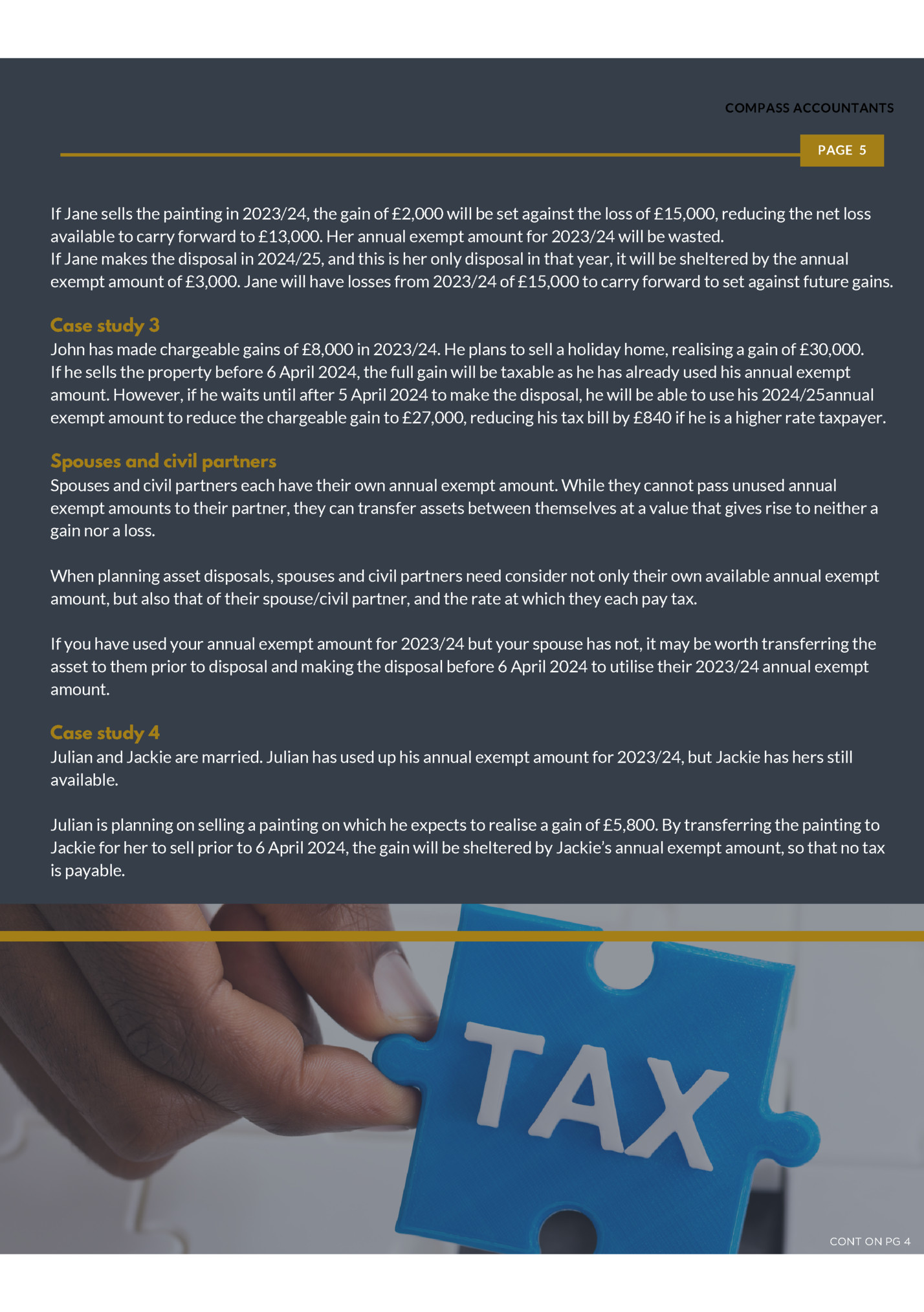
PAGE 6 Making use of your inheritance tax allowances It is often said that inheritance tax (IHT) is a voluntary tax, and one that can be avoided if you give away sufficient assets at least seven years before you die so the value of your estate is sheltered by your available nil rate bands. This is not always practical – people do not generally know when they are going to die and they need somewhere to live and the ability to fund their life in the meantime. However, there are various IHT allowances and exemptions that allow lifetime gifts to be made free of inheritance tax, even if you die within seven years of making the gift. Regular payments from income Gifts that you make from your income do not count as part of your estate for IHT purposes as long as you can afford to make the payments after meeting your living costs and the payments are made out of your regular income. For example, if you have surplus income each month, you could help a child with their rent, pay school fees for a grandchild or provide financial assistance for a relative. You can give away as much of your surplus regular income as you like, and also take advantage of various allowances and exemptions to make gifts from your capital free of IHT. IHT annual exemption The annual exemption allows you to make gifts of up to £3,000 a year without them being included in your estate for IHT purposes. Unlike many other annual exemptions and allowances, if the IHT annual exemption is not used in full for one tax year, the unused amount can be carried forward to the next tax year. However, the exemption for the current year must be used before any unused amount from the previous year. If you did not use your 2022/23 annual exempt amount, you can make gifts of up to £6,000 before the end of the 2023/24 tax year without them being added to the value of your estate. Small gift allowance The small gift allowance means that you can make gifts of £250 a year to as many people as you like without the gifts counting as part of your estate. However, there is a catch – gifts to the same person cannot benefit from both the small gift allowance and another allowance or exemption. Wedding and civil partnership gifts The value of this exemption depends on the relationship between you and the recipient of the gift. For wedding and civil partnership gifts to a child, the exemption is £5,000, for a grandchild, it is £2,500 and for a wedding or civil partnership gift to any other person, the exemption is £1,000. The same person can benefit from a wedding/civil partnership gift and other exemptions and allowances with the exception of the small gift allowance. For example, if you have not used your 2023/24 or 2022/23 annual exemption and your child marries before 6 April 2024, you could make a wedding gift of £11,000 free of IHT. Gifts to spouses and civil partners Gifts to spouses and civil partners can be made free of IHT without limit. Other gifts Exemptions also apply for certain gifts to charities or registered clubs, political parties, housing associations and to gifts for national purposes or public benefit.
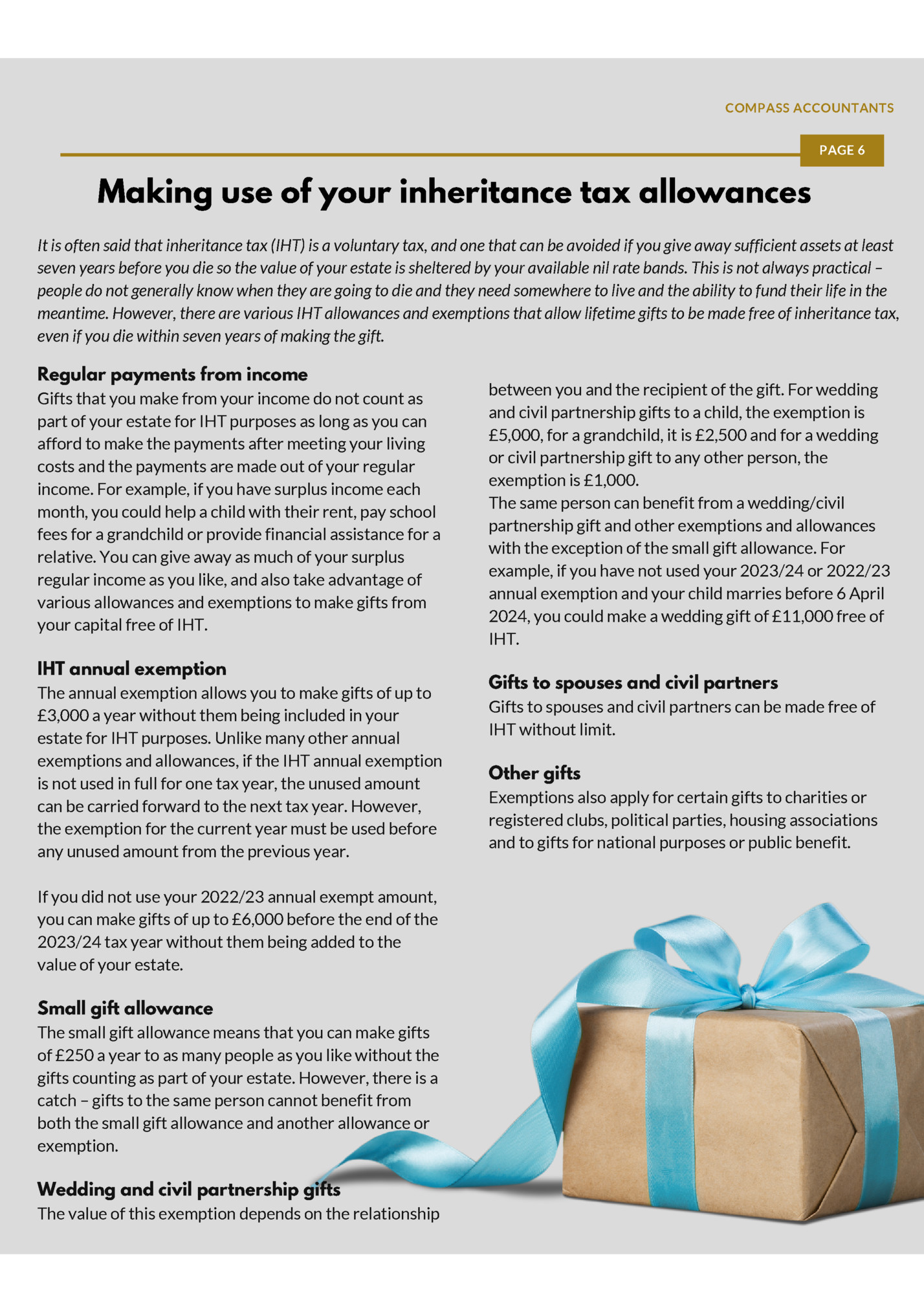
PAGE 7 Understanding your tax code Tax codes are fundamental to the operation of PAYE. If your tax code is correct, you should pay the right amount of tax on your PAYE income. However, if your tax code is not correct, PAYE will not work as intended and you may find that you have paid too much or too little tax. It is important, therefore, that you understand your tax code and also that you check that it is correct. Your tax code will normally comprise letters and numbers; however, there are special codes which may not follow this format. The number If you have a suffix code, the number in the tax code will indicate the amount of tax-free income you can receive in the tax year. This will reflect both your allowances and any deductions from your allowances. The number is the net amount of allowances less deductions without the last digit. For example, if you are entitled to the standard personal allowance of £12,570 and there are no deductions from your allowances, the number element will be 1257. Likewise, if you have received the marriage allowance from your spouse or civil partner so that your personal allowance has been increased to £13,830, the number element will be 1383. Deductions Amounts may be deducted from your personal allowance to allow tax on non-payrolled benefits in kind or untaxed interest or dividends to be collected through PAYE. Deductions may also be made from your tax code to collect underpayments of tax which may be the case if you have tax to pay under Self Assessment and you opted for this to be collected through PAYE via an adjustment to your tax code. For example, if you are entitled to the standard personal allowance of £12,570 and have a company car with a cash equivalent value of £5,000, your net allowances are £7,570 (£12,570 – £5,000) and the number element of your tax code is 757. Where you have a tax underpayment, the amount of the deduction is found by grossing up the tax that you owe at your marginal rate of tax (for example, if you owe £1,000 and pay tax at the higher rate, the deduction in your code would be £2,500 as 40% of £2,500 is £1,000). The letters The letters indicate your personal situation and how tax is to be deducted. The following letters may be used on the tax codes of English and Northern Irish taxpayers. CONT ON PG 8
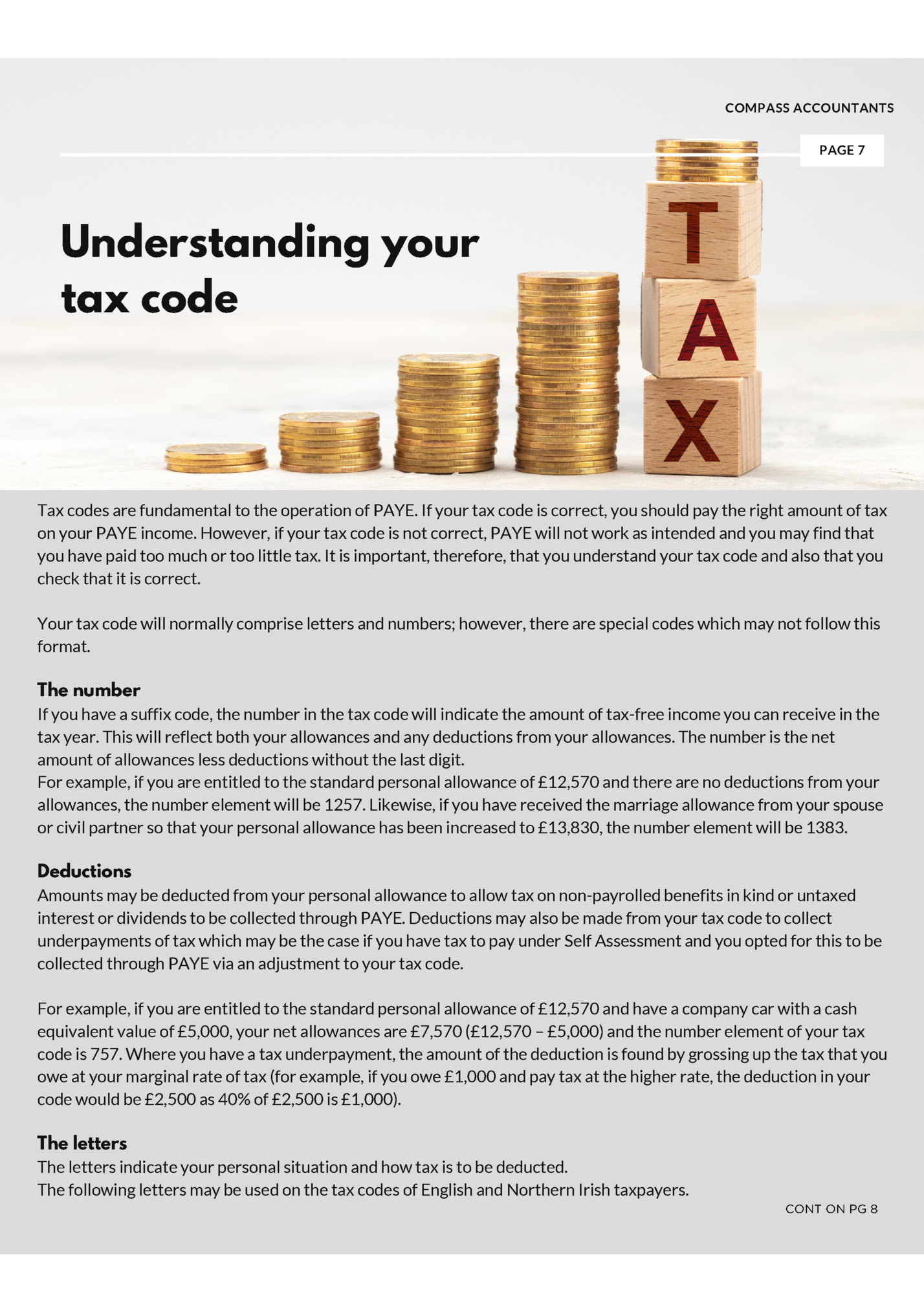
PAGE 8 LETTERS MEANING L You are entitled to the standard personal allowance M You received the marriage allowance from your spouse or civil partner N You have transferred the marriage allowance to your spouse or civil partner T Your tax code includes other calculations 0T Your personal allowance has been used up or you have started a new job and your new employer does not have the information they need to give you a tax code BR All income from this job or pension is taxed at the basic rate, usually where you have more than one job D0 All income from this job or pension is taxed at the higher rate, usually where you have more than one job D1 All income from this job or pension is taxed at the additional rate, usually where you have more than one job Scottish and Welsh taxpayers Scottish taxpayers have an ‘S’ in their code, for example, ‘SBR’, whereas Welsh taxpayers have a ‘C’, for example, CD0. K codes A K code is used where deductions exceed allowances. This may be the case if you do not receive a personal allowance because your income is more than £125,140 a year and you have deductions, for example, to tax benefits in kind. For a K code, the number element represents ‘additional pay’ which is added to your actual pay to collect the correct amount of tax. Deductions are subject to an overriding limit of 50% of pay. Emergency codes PAYE is normally operated on a cumulative basis. However, there are certain situations where you may be given an emergency code which indicates that your tax is calculated non-cumulatively by reference only to your pay for that week or month. An emergency code will end in ‘W1’, ‘M1’ or ‘X’, for example, 1257L M1. Check your code To avoid nasty surprises at the end of the tax year it is important to check that your tax code looks correct, and that you tell HMRC if it is not. You can do this via the HMRC app.
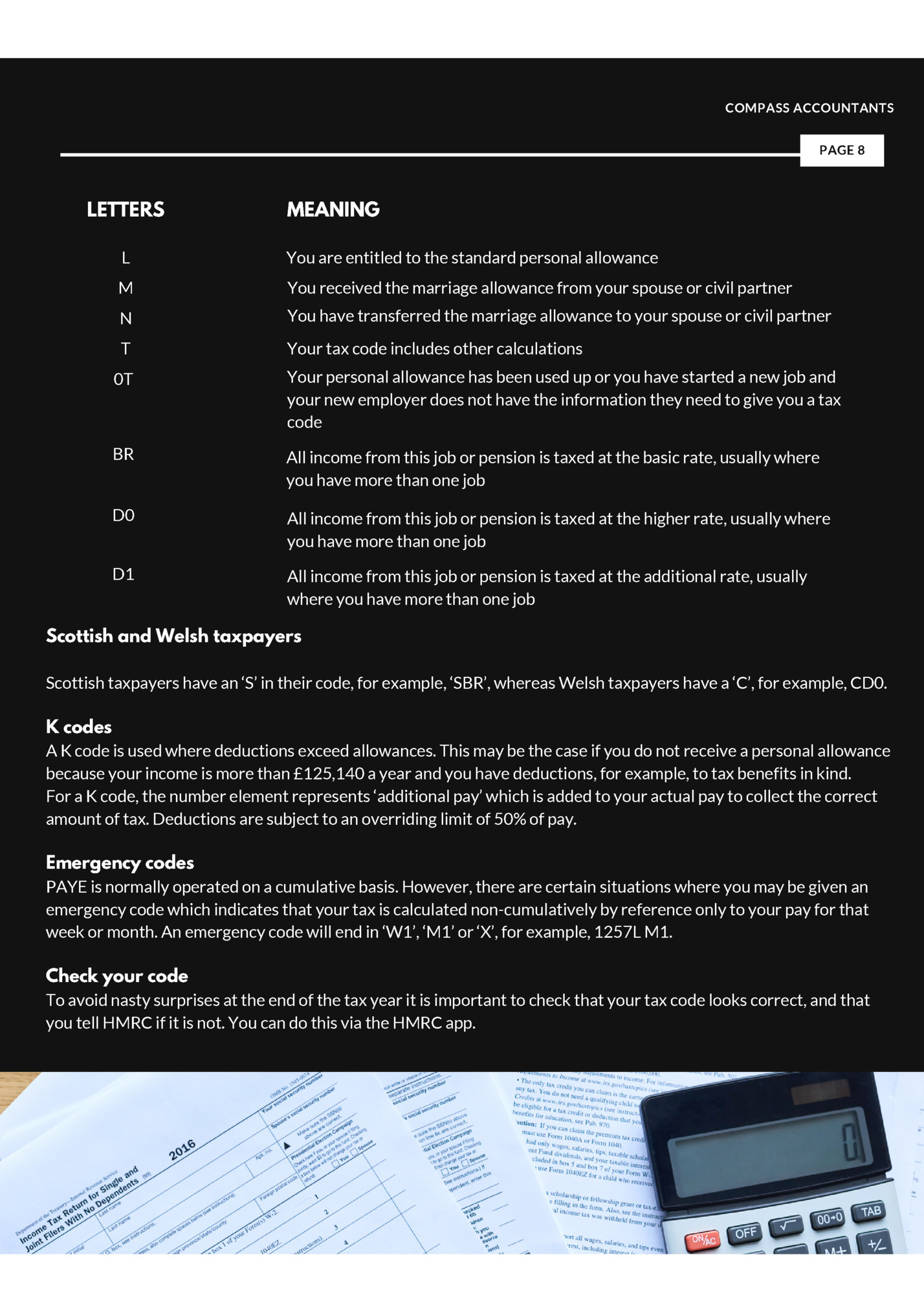
PAGE 9 TAX DIARY MARCH 2024 1 March 2024 – Due date for Corporation Tax due for the year ended 31 May 2023. 2 March 2024 – Self-Assessment tax for 2022-23 paid after this date will incur a 5% surcharge unless liabilities are cleared by 1 April 2024, or an agreement has been reached with HMRC under their time to pay facility by the same date. 19 March 2024 – PAYE and NIC deductions due for month ended 5 March 2024 (If you pay your tax electronically the due date is 22 March 2024). 19 March 2024 – Filing deadline for the CIS300 monthly return for the month ended 5 March 2024. 19 March 2024 – CIS tax deducted for the month ended 5 March 2024 is payable by today. For further information on any of the stories in this month’s newsletter, or for any other matter that Compass Accountants can assist you with, please contact us on 01329 844145 or contact@compassaccountants.co.uk To subscribe to the newsletter, so that each edition is delivered to your inbox, go to www.compassaccountants.co.uk and add your contact details. Compass Accountants, Venture House, The Tanneries, East Street, Titchfield Hampshire. PO14 4AR
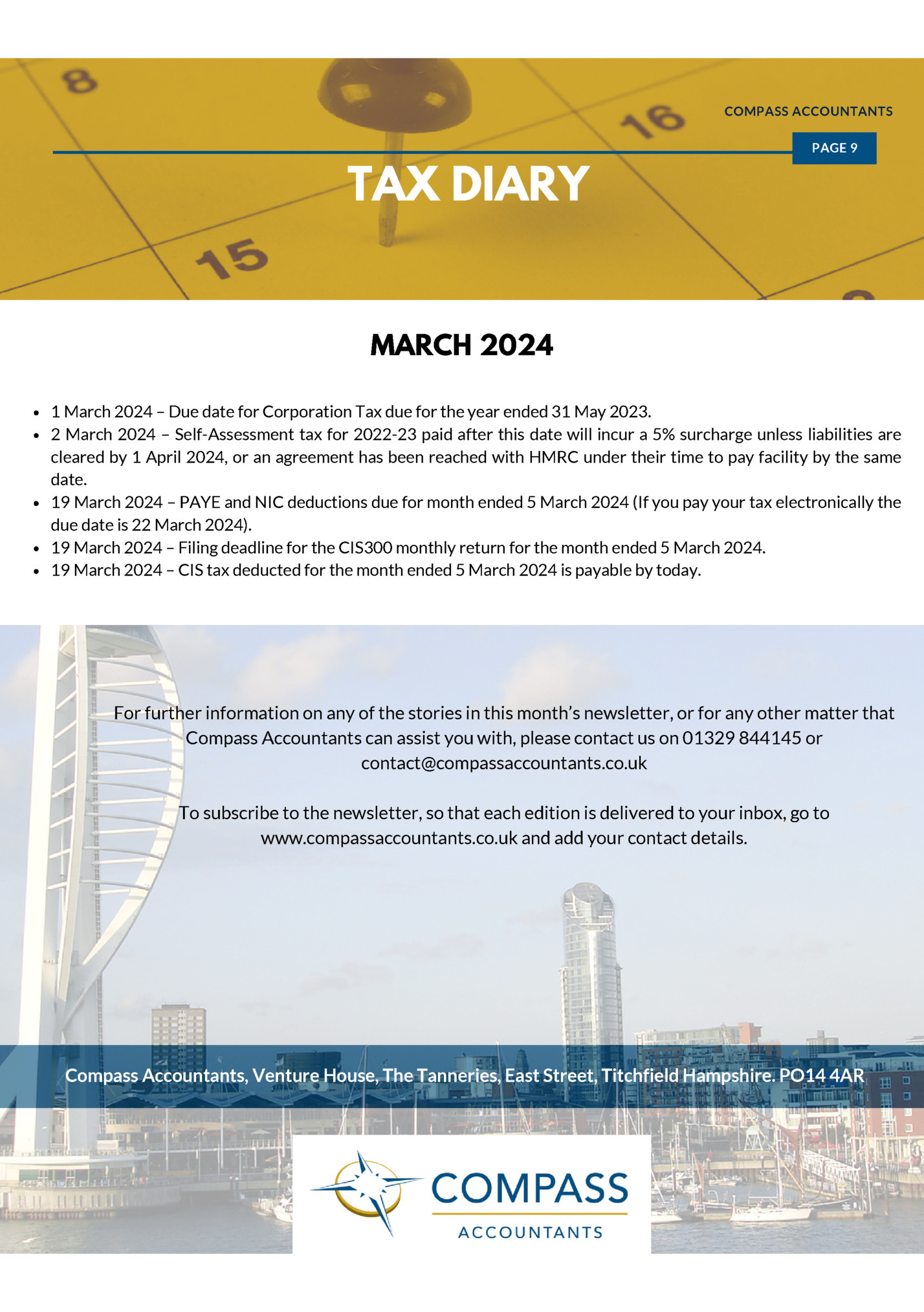
Fleepit Digital © 2021